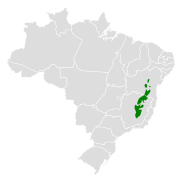Embernagra
| Embernagra | |
|---|---|

| |
| Pampa finch, Embernagra platensis | |
| Scientific classification | |
| Domain: | Eukaryota |
| Kingdom: | Animalia |
| Phylum: | Chordata |
| Class: | Aves |
| Order: | Passeriformes |
| Family: | Thraupidae |
| Genus: | Embernagra Lesson, 1831 |
| Type species | |
| Tanagra dumetorum[1] = Emberiza platensis Lesson, 1831
| |
| Species | |
Embernagra is a genus of South American finch-like birds in the tanager family Thraupidae.
Taxonomy and species list
[edit]The genus Embernagra was introduced in 1831 by the French naturalist René Lesson with the Pampa finch as the type species.[2][3] The name combines the names of two genera: Emberiza introduced for the buntings by Carl Linnaeus in 1758 and Tanagra introduced for the tanagers by Linnaeus in 1764.[4]
This genus was traditionally placed with the buntings and New World sparrows in the subfamily Emberizinae within the family Emberizidae.[3] A molecular phylogenetic study published in 2014 found that Embernagra was embedded in the tanager family Thraupidae. Within Thraupidae Embernagra is now placed with Coryphaspiza and Emberizoides in the subfamily Emberizoidinae.[5][6]
The genus contains two species:[6]
| Common name | Scientific name and subspecies | Range | Size and ecology | IUCN status and estimated population |
|---|---|---|---|---|
| Serra finch | Embernagra longicauda Strickland, 1844 |
Brazil
|
Size: Habitat: Diet: |
LC
|
| Pampa finch | Embernagra platensis (Gmelin, 1789) |
Argentina, Bolivia, Brazil, Paraguay, and Uruguay
|
Size: Habitat: Diet: |
LC
|
References
[edit]- ^ "Thraupidae". aviansystematics.org. The Trust for Avian Systematics. Retrieved 2023-07-16.
- ^ Lesson, René (1831). Traité d'Ornithologie, ou Tableau Méthodique (in French). Vol. 1. Paris: F.G. Levrault. p. 465 (livraison 6). Published in 8 livraisons between 1830 and 1831. For dates see: Dickinson, E.C.; Overstreet, L.K.; Dowsett, R.J.; Bruce, M.D. (2011). Priority! The Dating of Scientific Names in Ornithology: a Directory to the literature and its reviewers. Northampton, UK: Aves Press. p. 119. ISBN 978-0-9568611-1-5.
- ^ a b Paynter, Raymond A. Jr, ed. (1970). Check-List of Birds of the World. Vol. 13. Cambridge, Massachusetts: Museum of Comparative Zoology. p. 131.
- ^ Jobling, James A. (2010). The Helm Dictionary of Scientific Bird Names. London: Christopher Helm. p. 145. ISBN 978-1-4081-2501-4.
- ^ Burns, K.J.; Shultz, A.J.; Title, P.O.; Mason, N.A.; Barker, F.K.; Klicka, J.; Lanyon, S.M.; Lovette, I.J. (2014). "Phylogenetics and diversification of tanagers (Passeriformes: Thraupidae), the largest radiation of Neotropical songbirds". Molecular Phylogenetics and Evolution. 75: 41–77. Bibcode:2014MolPE..75...41B. doi:10.1016/j.ympev.2014.02.006. PMID 24583021.
- ^ a b Gill, Frank; Donsker, David; Rasmussen, Pamela, eds. (July 2020). "Tanagers and allies". IOC World Bird List Version 10.2. International Ornithologists' Union. Retrieved 20 November 2020.


